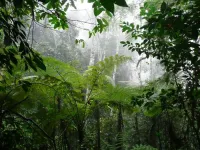(Press-News.org) A new approach to valuing the carbon storage potential of natural habitats aims to help restore faith in offset schemes, by enabling investors to directly compare carbon credit pricing across a wide range of projects.
Current valuation methods for forest conservation projects have come under heavy scrutiny, leading to a crisis of confidence in carbon markets. This is hampering efforts to offset unavoidable carbon footprints, mitigate climate change, and scale up urgently needed investment in tropical forest conservation.
Measuring the value of carbon storage is not easy. Recent research revealed that as little as 6% of carbon credits from voluntary REDD+ schemes result in preserved forests. And the length of time these forests are preserved is critical to the climate benefits achieved.
Now, a team led by scientists at the University of Cambridge has invented a more reliable and transparent way of estimating the benefit of carbon stored because of forest conservation.
The method is published today in the journal Nature Climate Change. In it, the researchers argue that saving tropical forests is not only vital for biodiversity, but also a much less expensive way of balancing emissions than most of the current carbon capture and storage technologies.
The new approach works a bit like a lease agreement: carbon credits are issued to tropical forest projects that store carbon for a predicted amount of time. The valuation is front-loaded, because more trees protected now means less carbon released to the atmosphere straight away.
The technique involves deliberately pessimistic predictions of when stored carbon might be released, so that the number of credits issued is conservative. But because forests can now be monitored by remote sensing, if projects do better than predicted – which they usually will – they can be rewarded through the issue of further credits.
The payments encourage local people to protect forests: the carbon finance they receive can help provide alternative livelihoods that don’t involve cutting down trees.
And by allowing for future payments, the new method generates incentives for safeguarding forests long after credits have been issued. This contrasts with the current approach, which passes on a burden for conservation to future generations without compensation for lost livelihoods.
The approach also allows different types of conservation projects to be compared in a like-for-like manner.
“Until now there hasn’t been a satisfactory way of directly comparing technological solutions with nature-based solutions for carbon capture. This has caused a lack of enthusiasm for investing in carbon credits linked to tropical forest protection,” said Dr Tom Swinfield, a researcher in the University of Cambridge’s Department of Zoology and senior author of the study.
He added: “Tropical forests are being cleared so quickly that if we don’t protect them now, we’re not going to make the vital progress we need towards net-zero. Buying carbon credits linked to their protection is one of the best ways to do this.”
Tropical forests play a key role in taking carbon dioxide out of the atmosphere, helping to reduce global warming and avert climate catastrophe. But the carbon they capture is not taken out of the atmosphere permanently: forests can be destroyed by pests, floods, fire, wind – and by human clearance.
This impermanence, and therefore the difficulty of reliably measuring the long-term climate benefit of tropical forest protection, has made it an unattractive proposition for investors wanting to offset their carbon emissions.
And this is despite it being a far cheaper investment than more permanent, technology-based methods of carbon capture and storage.
Protection of tropical forests, a nature-based solution to climate change, comes with additional benefits: helping to conserve biodiversity, and supporting the livelihoods of people living near the forests.
“Nature-based carbon solutions are highly undervalued right now because the market doesn’t know how to account for the fact that forests aren’t a permanent carbon storage solution. Our method takes away a lot of the uncertainties,” said Anil Madhavapeddy, a Professor in the University of Cambridge’s Department of Computer Science and Technology, who was involved in the study.
The new method, developed by scientists at the Universities of Cambridge and Exeter and the London School of Economics, is called ‘Permanent Additional Carbon Tonne' (PACT) accounting, and can be used to value a wide range of nature-based solutions.
“Carbon finance is a way for us – the carbon emitters of the richer world – to direct funds towards rural communities in the tropics so they can get more out of the land they have, without cutting down more trees,” said Andrew Balmford, Professor of Conservation Science at the University of Cambridge and first author of the paper.
Co-author Srinivasan Keshav, Robert Sansom Professor of Computer Science at Cambridge added: “Our new approach has the potential to address market concerns around nature-based solutions to carbon offsetting, and lead to desperately needed investment.”
Conversion of tropical forest to agricultural land results in vast carbon emissions. Around 30% of all progress towards the ambitious net-zero commitments made at COP26 is reliant on better management of carbon in nature.
Other carbon credit investment options include technologies that remove carbon dioxide from the atmosphere and lock it deep in the Earth for hundreds of years. These permanent storage options may currently be easier to value, say the researchers, but they typically cost substantially more than nature-based solutions and do nothing to protect natural habitats that are vital in regulating the global climate and mitigating the extinction crisis.
END
Offset markets: New approach could help save tropical forests by restoring faith in carbon credits
A new way to price carbon credits could encourage desperately needed investment in forest preservation and boost vital progress towards net-zero.
2023-10-30
ELSE PRESS RELEASES FROM THIS DATE:
Window to avoid 1.5°C of warming will close before 2030 if emissions are not reduced
2023-10-30
**CORRECTION**
We have identified an error in this press release. The fifth paragraph of the release originally read:
The researchers warn that if carbon dioxide emissions remain at 2022 levels of about 40 billion gigatonnes per year, the carbon budget will be exhausted by around 2029, committing the world to warming of 1.5°C above preindustrial levels.
However, this should read:
The researchers warn that if carbon dioxide emissions remain at 2022 levels of about 40 gigatonnes per year, the carbon budget will be exhausted ...
Why all languages have words for ‘this’ and ‘that’
2023-10-30
Why all languages have words for ‘this’ and ‘that’
Languages around the world have words for ‘this’ and ‘that’ according to new research from an international team, led by the University of East Anglia.
Researchers studied more than 1,000 speakers of 29 different languages to see how they use demonstratives – words that show where something is in relation to a person talking such as ‘this cat’ or ‘that dog’.
It was previously thought that languages vary in the spatial distinctions they make - and that speakers of different languages may think in fundamentally different ...
Low-income countries could lose 30% of nutrients like protein and omega-3 from seafood due to climate change
2023-10-30
The nutrients available from seafood could drop by 30 per cent for low-income countries by the end of the century due to climate change, suggests new UBC research.
That’s in a high carbon emissions and low mitigation scenario, according to the study published today in Nature Climate Change. This could be reduced to a roughly 10 per cent decline if the world were to meet the Paris Agreement targets of limiting global warming to 1.5 to 2 degrees Celsius - which recent reports have shown we’re not on track to achieve.
“Low-income countries and the global south, ...
Dong engineering spatial wood carbon scaffolds with nanocellulose fillers for water deionization
2023-10-30
Pei Dong, Assistant Professor, Mechanical Engineering, received $250,000 from the U.S. Department of the Interior for the project: "Engineering Spatial Wood Carbon Scaffolds with Nanocellulose Fillers for Water Deionization." This funding began in Sept. 2023 and will end in Sept. 2025.
This project seeks to create an innovative and energy-efficient capacitive deionization process with the help of biomass-based advanced porous structures for water desalination and purification.
###
About George Mason University
George Mason University is Virginia's largest public research university. Located near Washington, D.C., Mason enrolls 38,000 students from 130 countries ...
Gilleaudeau conducting geochemical analysis of carboniferous carbonates & implications for ocean oxygenation
2023-10-30
Geoffrey Gilleaudeau, Assistant Professor, Atmospheric, Oceanic and Earth Sciences (AOES), received funding for the project: "Geochemical Analysis of Carboniferous Carbonates and Implications for Ocean Oxygenation."
He and his collaborators aim to generate a new composite carbon record through the lower Mississippian in the Williston Basin. They also aim to generate a new record that tests the hypothesis that carbon excursion was related to an expansion of global ocean anoxia, ...
Russell studying Black displacement & mobility in Arlington County
2023-10-30
Russell Studying Black Displacement & Mobility In Arlington County
Donald Russell, Director, Provisions Research Center for Art & Social Change, Director, Mason Exhibitions, University Curator, College of Visual and Performing Arts (CVPA), received funding for the project: "Black Displacement and Mobility in Arlington County."
The goal of the project is to create a database of researched information that evidences Black displacement, migration, mobility, and the legacy of the Black diaspora that remains today in Arlington County.
The database will consist of maps, ...
New species of mosasaur named for Norse sea serpent
2023-10-30
Scientists have discovered a new species of mosasaur, large, carnivorous aquatic lizards that lived during the late Cretaceous. With “transitional” traits that place it between two well-known mosasaurs, the new species is named after a sea serpent in Norse mythology, Jormungandr, and the small North Dakota city Walhalla near to where the fossil was found. Details describing Jǫrmungandr walhallaensis are published today in the Bulletin of the American Museum of Natural History.
“If you put flippers on a Komodo dragon and made it really big, that’s basically what it would have looked like,” said the study’s lead ...
NSF funds holistic approach to help farmers adapt to climate change
2023-10-30
The National Science Foundation (NSF) awarded Emily Burchfield, Emory assistant professor of environmental sciences, $1.6 million to lead efforts to identify emerging pressures on agriculture in Georgia, Iowa and Ohio and to develop predictive models to help farmers and policymakers weather these changes.
“In a nutshell, we’re trying to understand what climate change will mean for agriculture in these three states,” Burchfield says. “We’ll be integrating biophysical projections based on environmental data with insights ...
University of Cincinnati study: ‘GPS’ seed devices effective in localizing breast tumors
2023-10-30
University of Cincinnati Cancer Center researchers found a seed device that acts as a GPS for surgeons to locate and remove breast and lymph node tumors was safe and effective.
The feasibility study evaluating the use of the devices, called SmartClips, was recently published in the journal The American Surgeon.
UC’s Jaime Lewis and her colleague Elizabeth Shaughnessy helped test the SmartClip devices as they were being developed.
“We went a few times and saw the different prototypes, worked with them, and provided feedback. ...
Researchers studying children’s health related to chemical exposures
2023-10-30
OKLAHOMA CITY, OKLA. – OU researchers have received a $1.8 million grant from the U.S. Environmental Protection Agency to establish a research center to address children’s cumulative health impacts from agricultural and non-chemical exposures. This grant will create the Children’s Environmental Health Center in the U.S. Southern Great Plains, which includes Oklahoma and Texas. The Center will focus on mitigating the chemical and non-chemical stressors that affect school absenteeism caused by gastrointestinal and respiratory diseases.
This collaborative center will be under the direction of Changjie Cai, Ph.D., assistant professor ...
LAST 30 PRESS RELEASES:
Optimized kinetic pathways of active hydrogen generation at Cu2O/Cu heterojunction interfaces to enhance nitrate electroreduction to ammonia
New design playbook could unlock next generation high energy lithium ion batteries
Drones reveal how feral horse units keep boundaries
New AI tool removes bottleneck in animal movement analysis
Bubble netting knowledge spread by immigrant humpback whales
Discovery of bats remarkable navigation strategy revealed in new study
Urban tributaries identified as major sources of plastic chemical pollution in the Yangtze River
UK glaucoma cases higher than expected and projected to reach 1.6 million+ by 2060
Type 2 diabetes prevention could more than halve carbon footprint linked to disease complications
Over 1 million estimated to have glaucoma in UK
Early treatment can delay rheumatoid arthritis for years
National childhood type 1 diabetes screening is effective and could prevent thousands of emergency diagnoses, UK study shows
Mix of different types of physical activity may be best for longer life
Continuous care from community-based midwives reduces risk of preterm birth by 45%
Otago experts propose fiber as first new essential nutrient in 50 years
Auburn Physics PhD student earns prestigious DOE Fellowship
AI tool helps you learn how autistic communication works
To show LGBTQ+ support, look beyond Pride Month
Using artificial intelligence to understand how emotions are formed
Exposure to wildfire smoke late in pregnancy may raise autism risk in children
Breaking barriers in lymphatic imaging: Rice’s SynthX Center leads up to $18 million effort for ‘unprecedented resolution and safety’
Dhaval Jadav joins the SETI Institute Board to help spearhead novel science and technology approaches in the search for extraterrestrial life
Political writing retains an important and complex role in the national conversation, new book shows
Weill Cornell Medicine receives funding to develop diagnostic toolbox for lymphatic disease
It started with a cat: How 100 years of quantum weirdness powers today’s tech
McGill researchers identify a range of unexpected chemical contaminants in human milk
Physical therapy research highlights arthritis’ toll on the workforce — and the path forward
Biomedical and life science articles by female researchers spend longer under review
Forgetting in infants can be prevented in mice by blocking their brain’s immune cells
Blocking immune cells in the brain can prevent infant forgetting
[Press-News.org] Offset markets: New approach could help save tropical forests by restoring faith in carbon creditsA new way to price carbon credits could encourage desperately needed investment in forest preservation and boost vital progress towards net-zero.



